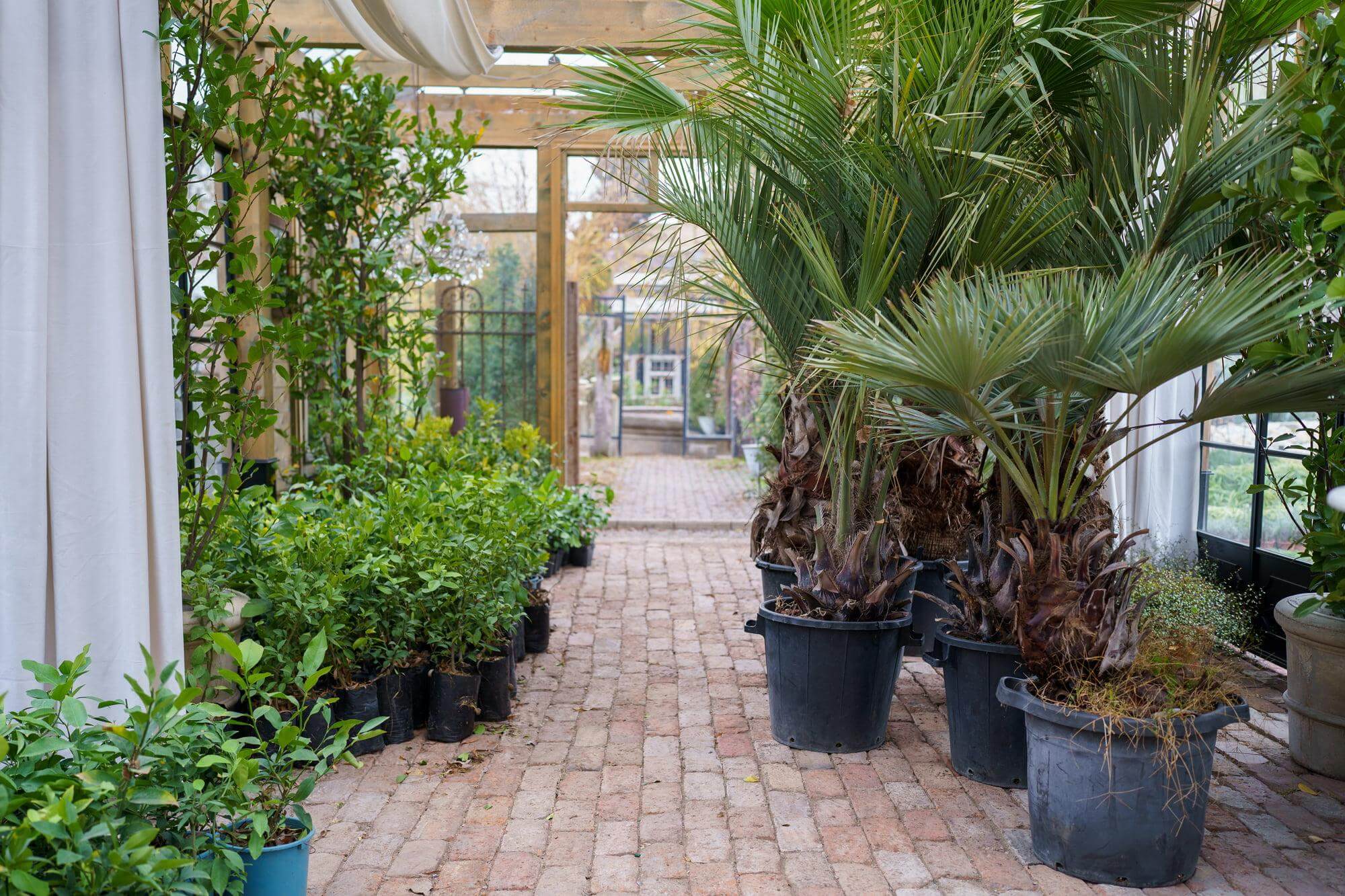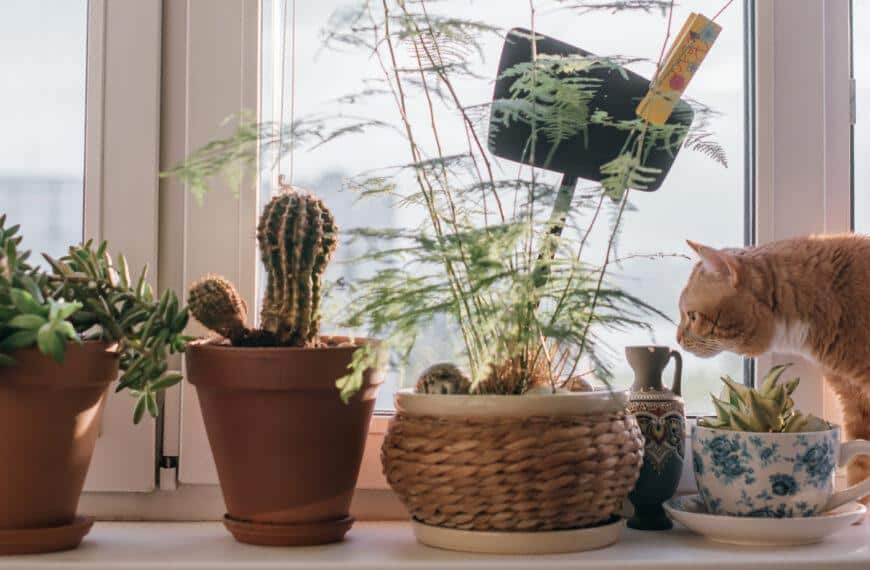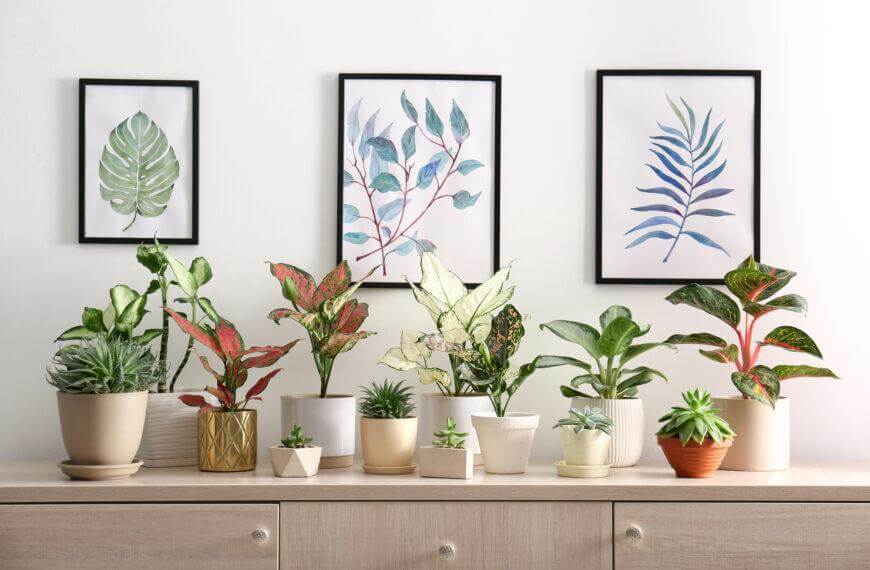Key Takeaways:
- Integrating plants into your home décor can bring a refreshing touch of nature indoors, making your living space more inviting and stylish.
- Before purchasing plants, take note of the space layout and natural light available in your home. Choose plants that complement your interiors and that will thrive in the specific lighting conditions of your home.
- Take inspiration from your natural surroundings when selecting plants for your home. Opt for plants native to your environment or that complement the surrounding landscape to create a cohesive and harmonious atmosphere.
- Choose design-centric vessels to complement your interiors, and use plants in abundance as a work of art. The right container and potting technique can elevate your plant into a statement piece that reflects your personal design aesthetic.
- Pay attention to seasonality and use plants to change the mood of your home according to the season. Consider using seasonal plants and flowers to add color and texture to your interiors.
Searching for methods to make your home more vibrant? Consider indoor gardening! It not only adds beauty and practicality to your living space, but it’s also surprisingly simple. Let’s find out how to begin!
Introduction: The Power of Plants in Interior Design
Plants have the power to transform and elevate any interior space, making them an essential element in interior design. They not only bring a touch of natural beauty but also offer practical benefits such as improving air quality and reducing stress levels. Integrating plants into interior design requires careful consideration of layout, natural light, furnishings, and the plant’s versatility. Interior designers have long recognized the ability of plants to freshen up a space and add a layer of texture and depth. Adding plants to a room can create a traditional, contemporary, tropical, or native feel depending on the species chosen. The decision of the vessel and arrangement is also a vital factor to consider in enhancing the aforementioned elements.
Interestingly, studies have shown that indoor plants have a positive impact on concentration levels, productivity, and mood. According to a report by NASA, some of the best indoor plants that improve air quality include:
- Ficus Triangularis
- Orchids
- Palm Trees
- Ferns
- African Violets
- Tropical Plants
- Cacti
- Rhipsalis
- Snake Plants
- Black Olive Trees
- Succulents
- Grape Ivy
These plants have essential qualities that clean and purify the air indoors.
Consider Your Layout and Decoration Before Purchasing Plants
Indoor Gardening: Tips for Integrating Plants into Your Home Design
Selecting the appropriate indoor plant species takes careful consideration of your home’s layout and decor in order to optimize plant life. Ensure that the size and shape of vessels align with the aesthetic of the room while also providing proper drainage. Consider the geography and seasonality of your location when selecting the plant species, for example, ferns and tropical plants thrive in humid environments. Additionally, avoid over-watering, especially with cacti and succulents.
When decorating with houseplants, start with a design concept that complements the overall interior style. Incorporate plants to accent furniture pieces and brighten up corners. The quality of natural light and temperature are significant to plant life, ensure the size and species you select thrive in the space. Adding a black olive tree or ficus triangularis in neutral-toned rooms provide a pop of green while adding texture and height. Orchids and grape ivy are excellent in grouping as they have similar growing conditions.
African violets and snake plants adapt well to all décor styles. Indoor plant ideas are infinite and personal preferences should direct selection; palm trees, ferns, cacti, rhipsalis, succulents, and other tropical plants are all practical options for spaces with sufficient light. By adding plants to your interior, your home will have improved air quality, a cozier ambiance, and a natural design flair.
Taking Note of Space Layout and Natural Light
When designing your living space with indoor plants, it’s important to take into consideration the layout of your space and the natural light available. Properly understanding these factors will ensure you choose the right plants that will thrive in your environment.
To optimize your space layout and lighting, position larger plants as focal points in an empty corner or beside a piece of furniture. Use smaller plants to fill gaps on shelves or hang them in baskets to add decoration without cluttering surfaces. Different plant species require different levels of sunlight, so place sun-loving plants near south-facing windows while shade-loving plants can be placed in areas with indirect light.
Keep in mind that some popular houseplants like orchids, palm trees, african violets, and black olive tree may require more maintenance and specialized care than others. Make sure to research the specific needs of each particular plant before adding them to your collection.
As for decorating with houseplants, consider choosing complementary pots or planters to enhance the overall aesthetic of your living space. You can also use layers of varying height by mixing tall floor-standing pots with tabletop-sized ones.
In summary, taking proper note of space layout and natural light is key to successfully integrating indoor gardening into your home decor. With some planning and attention to detail, you can create a harmonious balance between plant life and interior design elements that will promote both visual impact and healthy growth for your indoor garden.
Choosing Plants that Complement Your Interiors
When integrating plants into your home design, consider the layout and decor before selecting the ideal plants. The perfect plant complements your interior style to create a cohesive aesthetic.
Look for plants that match your color palette and decorative accessories such as pots or stands. Consider the natural light available in each room and the humidity levels in your home to select plants that thrive in those conditions.
To create a harmonious blend of nature and interior design, opt for larger plants to fill corners and smaller greenery to accessorize shelves and tabletops. Orchids are elegant and timeless, adding sophistication to any room.
Did you know? According to the American Society for Horticultural Science, houseplants can improve indoor air quality by removing harmful toxins from the air we breathe.
Take Inspiration from Your Natural Surroundings
Integrating the beauty of nature into your home decor is an exciting way to bring a new and refreshing feel to your living space. By incorporating natural surroundings into your home, you can create a warm and inviting atmosphere that makes you feel calm and serene.
Plants are an excellent way to bring this concept into your home and add a touch of greenery to your living space.
To take inspiration from your natural surroundings, consider the plants, trees, and flowers in your backyard or nearby park. Take a walk around and observe the colors, shapes, and textures of the plants. This will help you identify the types of plants that complement your home decor. Once you have identified the plants that appeal to you, decorate with houseplants, orchids, and other foliage to create a natural ambiance within your living space.
To add a unique touch to your indoor garden, you can incorporate different varieties of plants such as ferns, succulents, and bonsai trees. These plants can be placed in different parts of your home, such as the living room, bedroom, or kitchen. You can also consider adding a natural-looking aquarium or terrarium to your home decor. These can add a touch of nature to your living space while also providing a relaxing environment for your fish or pets.
If you are looking to incorporate plants into your home decor, now is the time to do so. Don’t wait any longer to bring nature into your living space. By doing so, you will not only create a more beautiful environment in your home but also improve your well-being by adding more oxygen and reducing stress levels. So, get started today and decorate your home with beautiful foliage to enjoy all the benefits that nature has to offer.
Sourcing Plants Native to the Environment
One way to create an indoor garden that is both beautiful and environmentally friendly is by sourcing plants that are native to the surrounding environment. Not only will this help preserve local plant species, but it can also enhance air quality and promote natural ecosystems. To start sourcing native plants, research what plants grow natively in the region and where they can be purchased.
Incorporating native plants into home decor can also add unique aesthetics to any space. By choosing plants that thrive naturally in the surrounding environment, one can easily decorate with houseplants while maintaining a natural and cohesive design theme. One way to do so is by creating a wall or tabletop garden using locally sourced soil, recycled materials for pots, and indigenous plants.
While finding native plants may seem daunting at first, many local nurseries and botanical gardens offer a variety of options. Another option is to join a community garden or plant exchange group, where members share their knowledge of native plant varieties and sources.
A friend once shared how her family transformed their home with potted succulents sourced from their California backyard. They repurposed old tin cans as pots and arranged them on shelves in their house for Hawaiian vibes in sunny San Diego.
Choosing Plants that Complement the Surrounding Landscape
Plants that Match the Surrounding Landscape
- Consider climate, sunlight, and soil type when selecting plants for your indoor garden.
- Choose plants with colors and textures that complement your home’s architecture.
- If you live in an urban or suburban environment, select plants that thrive in low-light conditions.
- Pick fragrant plants to create a relaxing atmosphere in your home.
When choosing the perfect plant for your indoor garden, be sure to take into account factors such as lighting and temperature. Finding balance between aesthetics and plant health is essential.
Don’t miss out on the opportunity to incorporate natural elements into your home decor. By selecting plants that match your surrounding landscape, you can breathe life into any room.
Add some greenery and watch as it transforms not just physical space but also mental space by creating a calmer more relaxed feel in any given area. So go ahead, get yourself some lovely greens today!
Opt for Design-Centric Vessels
Design-Centric Vessels for Indoor Gardening
Giving plants a stylish and modern look is easy with design-centric vessels, adding an artistic touch to your indoor gardening display. Placing your plants in elegant pots, vases or terrariums can enhance your home decor and make any room stand out. Choosing vessels that complement your decor style can create a beautiful and cohesive look.
Design-inspired containers come in various shapes, sizes, colors, and materials. Blending these features with your choice of plants can elevate your green space to a whole new level. From glass to ceramic, metal to concrete, choose a vessel that aligns with your personality and reflects your sense of style.
Whether it is a statement piece or a collection of smaller vessels, adding design-centric vessels to your indoor garden collection can bring positive energy, relaxation and happiness to your living space. So why settle for a plain pot, when you can showcase your plants in something more unique and beautiful? Step up your indoor gardening game with design-centric vessels and let your plants thrive in style.
Importance of Finding the Right Container
The suitable design of the container plays a crucial role in indoor gardening. Choosing the right vessel for your plants ensures their healthy growth, enhances their aesthetic appeal, and complements your home decor. Plants should not only beautify your space but also provide a tranquil ambience.
Vessels that are specifically designed to accommodate plant life will optimize plant growth and minimise disruption to their roots. Choosing a vessel that accommodates adequate drainage is essential in maintaining optimal soil moisture levels while reducing soil erosion.
Plants thrive best under favourable environmental conditions, which include access to light and sufficient nutrients. Container designs that require less frequent watering and harvesting routines allow you to dedicate ample time towards other activities while not compromising on plant health.
Plastic containers have been found lower-quality with issues such as cracking or breaking when exposed to sunlight over a prolonged period. Ceramic, porcelain, wood or metal containers serve as an elegant solution for indoor gardens for plant growth optimization and home decor integration.
Source: https://www.apartmenttherapy.com/container-tips-for-indoor-gardening-and-home-decor-36720172
Using Plants in Abundance as a Work of Art
Plants can be used as a magnificent piece of art in our homes. The abundance of plants gives a natural and soothing effect to the ambiance. Plants bring life to the interior of homes and give an aesthetic value that is not just visually appealing but also beneficial to health.
By using plants as a work of art, we can make our living space more beautiful and healthier, providing fresh air to breathe in and creating an enchanting environment. Varying sizes, colors, textures, and shapes add depth and vibrancy to the room’s design while lowering stress levels. With the wow factor achieved using plants, you won’t need any other decoration.
Using plants creatively in your home decor emphasizes your personality traits while becoming an extension of your personal style. They can act as accent pieces for tables and shelves or be incorporated into other spaces such as bathrooms, bedrooms-even kitchens! There are various options available when it comes to indoor gardening- vertical gardens, hanging baskets or using unconventional vessels like glass jars or wooden crates.
Incorporating exotic plant species like succulents or hedge cactus brings new texture to space providing never-seen-before combinations with existing furniture and décor elements shining a spotlight on highlighted areas much-needed sunlight without actual natural resources required.
Our friend Monica always has at least eight different kinds of cactus indoors; her friends are always fascinated by how they enhance her simple living room into something spectacular while being lower maintenance compared with flowers that demand utmost attention or care.
Choosing Beautiful Containers and Potting Techniques
Selecting Attractive Planters and Potting Techniques to Enhance Your Indoor Garden’s Beauty
Choosing the right containers and utilizing the best potting methods for your plants is essential for both their health and aesthetic appeal. Follow these four simple steps to create a remarkable indoor gardening space:
- First, determine what kind of plant you want to grow, then choose a suitable container that will accommodate its size and requirements.
- Ensure there are drainage holes in the container for excess water to escape.
- Mix the appropriate amount of soil into your container, leaving enough space at the top for oxygen circulation.
- Finally, strategically place your plant where it will receive adequate sunlight.
To truly make your indoor garden stand out, consider some special details like adding unique containers with diverse textures or colors or incorporating various potting techniques such as using moss instead of soil or experimenting with vertical gardens. Creating an environment that mimics natural outdoor spaces can also be appealing.
Add a touch of elegance to otherwise plain pots by painting them in bold colors or adding artistic elements like mosaic tiles. Alternatively, try adding small decorative stones on top of the soil surrounding your plants or use pots made from sustainable materials such as coconut husks or recycled plastic.
By choosing eye-catching planters and applying innovative potting techniques, you can achieve a beautiful yet functional indoor garden space.
Pay Attention to Seasonality
Seasonal considerations are crucial when it comes to indoor gardening and home decor. To ensure that your plants thrive, it is important to choose ones that can withstand the temperature and lighting conditions of each season. Different seasons have unique characteristics that impact plants differently. For example, in spring, plants require more light and warmth, whereas in winter, they need less light and cooler temperatures. Paying attention to these seasonal changes will help you choose the best plants for each room in your home.
In addition to temperature and lighting, it’s also essential to consider the natural growth patterns of your plants. Some plants grow only during specific seasons while others grow year-round. When deciding on which plants to grow, consider their growth habits and how they will fit into your home decor. Integrating plants with complementary colors and textures can add depth and character to any room. Don’t be afraid to switch up your indoor garden with the seasons to keep your home feeling fresh and vibrant.
Finally, it’s important to consider the location of your plants in your home. Some plants thrive in bright, sunny windows, while others prefer low to medium light areas. Additionally, certain rooms in your home may have more humidity than others, which can impact the health of your plants. By carefully choosing the right location for each plant, you can ensure that they flourish and contribute to the overall ambiance of your home. Remember that the placement of your plants is just as important as the plants themselves.
Using Plants to Change the Mood According to Season
Integrating plants into your home decor can contribute to the changing mood according to season. Plants that bloom in spring and summer bring warmth and energy, while those with evergreen foliage can offer a sense of serenity and calmness during colder months.
Incorporating seasonal plants into your indoor garden helps create a natural beauty that aligns with each season’s ambiance. The bright hues of fall-inspired flowers such as pansies and chrysanthemums add a touch of elegance to any room, while winter jasmine and narcissus remind us of the renewal of spring.
While creating an indoor garden, consider decorative pots, baskets, or containers that correspond to each season’s spirit. Consider placing indoor plants beside sunny windows or warm lighting sources where they can thrive. Incorporating different leaf shapes, flower colors, textures adds depth to your plant collection.
Welcome new guests with seasonal arrangements crafted from indoor plants – scents from floral blooms bring life to common areas, upping your inter-personal relationship. When nature is at its most restless outside – making inside feel like an oasis where anything could happen!
Examples of Seasonal Plants and Flowers
When it comes to plants and flowers, the changing seasons offer a variety of options that can easily be integrated into your indoor garden. Here are some examples of seasonal plants and flowers for your consideration:
- Spring: Daffodils, Tulips, Lilacs
- Summer: Sunflowers, Lavender, Hibiscus
- Fall: Chrysanthemums, Pansies, Dahlias
- Winter: Poinsettias, Amaryllis, Cyclamen
These are just a few examples of seasonal plants and flowers that can add beauty and vitality to your home. Incorporating these varieties can bring a new dynamic to your indoor gardening routine.
In addition to the usual seasonal offerings, there are also unique variations available such as exotic orchids or fragrant Herbs. Try experimenting with different arrangements and planting techniques to create new and exciting looks.
Don’t miss out on the opportunity to enrich your home with beautiful botanicals! Whether you choose to keep things simple or get creative with complex arrangements, integrating indoor gardening into your space is a great way to add life and color all year round.
Conclusion: Bringing the Outdoors into Your Home with Plants.
Bringing Nature Indoors: Enhancing Home Decor with Plants
Integrating plants into your home design is an excellent way to bring the beauty of nature indoors. Plants offer a variety of benefits, including purifying the air, reducing stress, and adding color. By selecting the right plants, you can create a relaxing, peaceful environment while also adding to your home’s aesthetic appeal.
To achieve this, start by selecting plants that complement your existing decor. Consider the size, shape, and color of each plant, and choose plants that will enhance the overall look of your space. Additionally, be mindful of the amount of light and water each plant requires and ensure that you can provide the appropriate conditions.
As you integrate plants into your home decor, don’t be afraid to get creative. Use plants of different sizes and heights to add dimension to your space, and mix and match textures to create an interesting visual appeal. You can also experiment with different types of containers to add a unique touch to each plant’s display.
Finally, consider incorporating plants into unconventional spaces, such as your bathroom or kitchen, to further enhance their visual impact. By being mindful of the unique climate and lighting conditions of each space, you can create a cohesive and inviting environment throughout your home.
Five Facts About Indoor Gardening and Home Decor:
- ✅ Indoor gardening is a great way to add some greenery and life to your home decor. (Source: Better Homes & Gardens)
- ✅ Plants not only bring aesthetic appeal but also offer several health benefits by purifying the air and reducing stress. (Source: The Spruce)
- ✅ There are several different types of indoor plants to choose from, including low-light plants, hanging plants, and succulents. (Source: Real Simple)
- ✅ Indoor gardening can be done in a variety of ways, such as using decorative planters, vertical gardens, or hydroponic systems. (Source: House Beautiful)
- ✅ Integrating plants into your home design can be done in a way that complements your existing decor style, such as incorporating plants into a minimalist or bohemian style. (Source: Apartment Therapy)
FAQs about Indoor Gardening And Home Decor: Integrating Plants Into Your Home Design
What is indoor gardening and home decor, and how can I integrate plants into my home design?
Indoor gardening and home decor involves including plants and greenery in your home space to add a natural touch. To integrate plants into your home design, consider selecting plants that match your decor style, using hanging planters or shelves, and incorporating plants into your wall decor.
What are some easy-to-care-for plants that are suited for indoor gardening?
Some easy-to-care-for plants that are suited for indoor gardening include succulents, snake plants, spider plants, peace lilies, and pothos. These plants are low maintenance, require minimal watering, and are suitable for a variety of lighting conditions.
How can I create a green space in a small apartment or condo?
To create a green space in a small apartment or condo, consider using vertical planters, hanging planters, or multi-tiered shelving to make optimal use of your limited space. You can also select plants that are small in size or use miniature versions of larger plants to create a lush atmosphere without sacrificing square footage.
Are there any benefits to having plants in my home?
Yes, there are many benefits to having plants in your home. They can improve air quality, reduce stress levels, boost mood and productivity, and even increase creativity.
How can I incorporate indoor gardening and home decor into my workspace?
To incorporate indoor gardening and home decor into your workspace, consider adding plants to your desk or windowsill, using hanging planters or shelves, and displaying plants in stylish containers. You can also select plants that are known for their air-purifying properties, which can create a healthier work environment.
What are some ways to maintain healthy plants for indoor gardening?
To maintain healthy plants for indoor gardening, make sure to provide them with adequate sunlight, proper soil, and regular watering. Additionally, make sure to keep an eye out for common issues like pests or over-watering, and prune your plants regularly to keep them looking their best.




